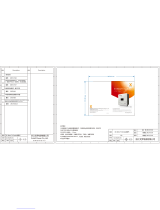
The inverter must be installed under a canopy if installing externally. Avoid direct
sunlight and near water sources
Mount the inverter at least 3 feet above ground level (outside only)
The inverter must be installed in an easily accessible location, the status display
must be visible and not obstructed
Please ensure that the wall to be mounted on is sucient enough to hold the weight
of the inverter and battery pack
The inverter must be installed in a well ventilated area, the ambient temperature
should be below 40ºC to ensure optimal operation
The inverter must be installed vertically with connections always positioned at the
bottom, never install horizontally, and avoid tilting the unit
Extra care and attention must be taken when installing and maintaining any GivEnergy equipment.
The system is capable of retaining a high voltage, even when disconnected.
Safety Instructions
SAFETY AND INSTALLATION
Precautions
All electrical installations must be carried out by a qualied and registered Electrician and in accordance
with the IEE Wiring Regulations
During operation, the heat sink may become hot. Do not touch the heat sink at the sides, or the top
of the inverter when in operation
The inverter is designed to be connected to the grid; connecting your inverter to a generator or
other power source can result in damage to the inverter or external devices
All GivEnergy equipment must be installed by a GivEnergy Approved Installer
If any damaged or missing parts are found, please contact GivEnergy on 01377 252 874 or email
support@givenergy.co.uk immediately. Returns must be provided in original or equivalent packaging
If you suspect something is wrong with the inverter, contact GivEnergy on 01377 252 874 or email
support@givenergy.co.uk
It is very important for system safety and ecient operation to use appropriate cables for battery
connections. 16mm2 (minimum) tri-rated cables must be used for DC battery connections
The battery must be installed in accordance with the Battery Installation Guide
The voltage of the battery connected must not exceed 60V (or it will damage the inverter and void any
warranty)
Only GivEnergy batteries should be connected to our inverters
Reversed polarity will damage the inverter

















